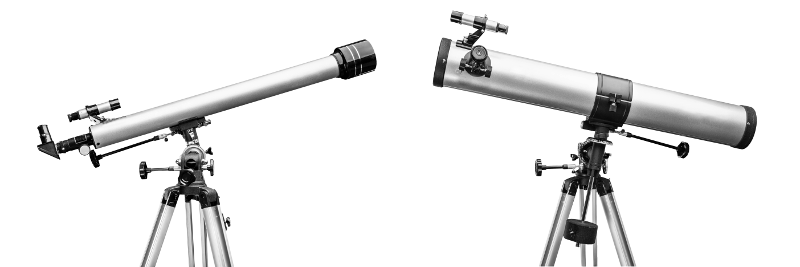
Two distinct types of optical telescopes, refractors and reflectors, are capable of revealing the glories of the universe. And both kinds achieve this magic by performing a couple of basic actions. First, they gather larger amounts of light than the human eye can do on its own. This alone allows seemingly invisible objects to be seen. Any object that throws off light will radiate it in all directions. If the amount reaching a viewer’s eyes is below the threshold of human light sensitivity, it simply won’t be seen. Collecting more of this scattered light over a wider field lets it reach a level of intensity that’s detectable to humans. Next, this gathered light has to be focused to create a magnified image. Refractive and reflective scopes differ dramatically in performing the initial task, but they’re very similar in performing the second job.
Refracting Scopes
The refractor telescope starts things off by gathering light through a primary lens also known as an objective. In the simplest setup, this large lens focuses light down the main body, the optical tube, to create an image at the focal plane. A smaller eyepiece lens then magnifies this image. The easiest way to adjust the eyepiece is by placing it in a smaller tube that slides in and out of the rear of the main optical tube. With a history going all the way back to 1608, refractive instruments are oldest type. One of the original inventors of this device, Hans Lippershey, used a convex objective lens and a concave eyepiece lens. It was this model that Galileo used when he produced his own version for astronomical purposes the following year. Later, astronomer Johannes Kepler switched the concave eyepiece with a convex one for improved magnification.
Further Enhancements
As instrument makers attempted to use bigger, thicker objective lenses, they discovered color distortions in the resulting images. Different frequencies of light travel at different speeds through solid transparent materials like glass. This causes them to exit the material at different angles and separate from each other. In the mid-18th century, it was realized that if a convex lens was coupled with an additional lens possessing a flat surface and a concave surface, the color separations were corrected as various frequencies were realigned. The introduction of these achromatic lenses allowed for thicker objective lenses that shortened the length of the optical tube. Next, apochromatic lenses were invented that used chemically altered glass for further color correction. A relatively small improvement found in modern refractive scopes is the use of a prism to permit the eyepiece to be placed at a 45 degree angle to the optical tube.
Reflective Scopes
The reflector telescope relies on a concave mirror to gather light. The curvature of this mirror focuses the light while also reflecting it to produce an intensified image on a focal plane. The basic version, called a Newtonian scope in honor of its inventor, Isaac Newton, uses a small angled mirror placed just before this focal plane to deflect it 90 degrees to the side of the main optical tube. This allows the magnification eyepiece to be placed in its own adjustable holder attached to the main optical tube near the top for easy access.
The Reflective Advantages
On a refracting instrument, the objective lens has to be ground into shape on both its front and back. A concave mirror only has to be ground into shape on one side. This difference gives the reflective scope a big cost advantage. Next, any flaws or impurities anywhere in the lens glass will distort the image. Only the mirror surface has to be free of mistakes. Also, since objective lenses are only supported around their edges, beyond a certain diameter, they’ll literally begin to droop in the middle from their own weight. Concave mirrors can be produced with much larger diameters because they’re supported across their entire back. A final plus for concave mirror devices is their ability to reflect all frequencies of light in unison. There are no chromatic distortions. Refractive devices do have the advantage, though, in being completely sealed at both ends to keep dust, dirt, and condensation out. This, along with a simple, linear design, also make them preferred for binoculars, camera accessories, and surveillance scopes.
Improving on Newton
Newtonian devices might have relatively shortened bodies, but the Cassegrain type manages to squeeze things into an even shorter body. Rather than place a diagonal mirror near the end of the focal length, the Cassegrain places a convex mirror at the halfway point to reflect the light rays back through an opening in the main concave mirror. This maneuver places the eyepiece at the rear where it resembles a refractive setup while still maintaining the advantages of a Newtonian instrument.
